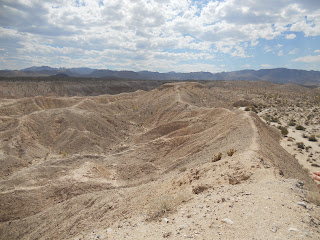 |
| Windmills along the highway. |
We have officially entered the "Windy Season" in Imperial Valley. When I first got here and looked at the windmills that were being built, I couldn't imagine they would actually collect much energy because there was never any wind. Then this last week something magical happened in the atmosphere and the winds have come to the valley. They tend to range from 7-20 miles per hour all day and you can hear them whipping around the trailer all night long. Now I understand why people think windmills were a good idea here!
The Ocotillo Wind project has been putting up windmills since before I got here and it is amazing to see how fast they go. Three or four can go up in a day. I imagined they were big, complex things that took days to put up just one. But the main parts are built elsewhere and trucked in, then put up in a few easy steps. Base, pole, turbines. On to the next one.
 |
| Ocotillo Wind Project, in front of the Coyote Mountains |
The wind project here is hugely controversial. I have yet to take pictures of my two favorite examples so you'll have to check back here later and I'll add them in. One is a painted sign on a fence with the Grim Reaper and the message is along the lines of "Death to Windmills". Right across the street is a small market that put up a very large sign: "Wind Project Workers Welcome Here". That pretty much sums up the way the town is divided. Some are in favor of wind energy and argue that the project creates jobs. They point out that the area has been an energy corridor for over thirty years and nothing has been done until now, and say the people who are against the project should have spoken up sooner because it's a done deal now. Those who are against the project range from environmentalists (tearing up the desert and disturbing animals as well as digging up the Ocotillo cactus) to Native Americans (the land being built on is really close to sacred grounds, and may actually be on some of them) to townspeople who don't like the change in the view. They argue that no one hires local people to work on the project and while local resources go to supporting it, the energy actually goes to San Diego. Ocotillo won't see any benefits and gets all the problems.
 |
| Windmill, in the process of going up. |
In general I am in favor of green energy. Getting away from oil, fossil fuels, coal, etc. and moving towards clean, renewable, earth-friendly energy will always get my vote. But last week Jessica and I went on a hike in a wash across the road from the windmills. There were cactus all over the place, river rocks and fossilized algae from when the area used to be a lake, and it was much more green and alive than you usually imagine a desert being.

But as we were walking back we came across some huge, heavy machinery tire treads that had torn up the ground. And just beyond that was the base of a new windmill. We were really surprised to just stumble across one like that- we hadn't known they were coming onto the other side of the highway. And it was a really great example of one of the reasons people don't want the windmills to be put up. The area was so different it was sad. Lawsuits have prevented the company from starting up the standing windmills, but apparently don't prevent new windmills from being built, and in the end they will have only slowed down the inevitable.
 |
| UFO? No, just the base of a new windmill. |
I'm not necessarily going anywhere profound with this post, just thinking about the changes in the desert and how even something I support, like green energy, is not always a completely good thing.
10/14 Update: Finally got the photos of the signs I was describing:

















































